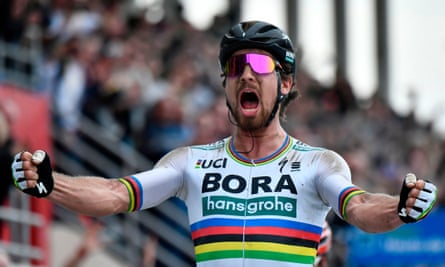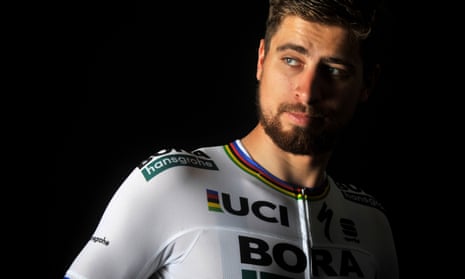“I was thoroughly fucked but I tried to enjoy it afterwards,” Peter Sagan says with a grin as he explains how he felt after winning the Paris-Roubaix classic this month. “When I was younger, it was always my dream to win Paris-Roubaix. I didn’t think about the world championships and [the Tour of] Flanders.”
Sagan is the most popular rider in cycling today and, with the murky uncertainty surrounding Chris Froome and Team Sky, his victory felt like a shaft of light which revealed panache and grit. They call Paris-Roubaix the ‘Hell of the North’, because its 29 cobbled sections have a bone-juddering impact on even the toughest and most brilliant riders. It is also the glittering peak among the five monuments which are cycling’s oldest and most prestigious one-day races.
This year the severity of the challenge was underlined by the death of the young Belgian cyclist Michael Goolaerts, who suffered a cardiac arrest. For just under six hours Sagan was in a battle and his feat was accentuated by the fact he broke for glory a startling 53km from the finish. The Swiss cyclist Silvan Dillier clung to a narrow lead as they entered the velodrome, but Sagan was imperious in the final 100m.
“Twice I didn’t finish Roubaix,” Sagan says, “and in those races I did finish I was in much worse condition than this year. If you’re fighting for first position your emotions are very different. I was not thinking: ‘This is the hell of the north.’ But you realise one, two, three days later how tired you are. Especially the first morning, I was so tired when I woke up from shaking on the cobblestones.”
Sagan sinks into the couch in a Maastricht hotel. We’re a week past Paris-Roubaix and it’s the day before he finishes fourth in the Amstel Gold Race – a 261km ride featuring 35 serious climbs – and the toll is obvious. Yet he is much more involved than he had been in a stilted press conference preceding our interview. As the routine questions from the Dutch press corps arrived slowly, Sagan quipped: “Is this a funeral?”
Here, in a more relaxed setting, it seems appropriate to consider Sagan’s remarkable rise from obscurity in Slovakia to becoming the world’s premier sprint cyclist and star of the peloton. The 28-year-old, who rides for the German team Bora-Hansgrohe, became the first reigning world champion to win Paris-Roubaix since Bernard Hinault in 1981. This second classic, after Sagan won Flanders in 2016, sits alongside other milestones. Last year only a controversial disqualification, after Mark Cavendish fell heavily in a bunch sprint, ended Sagan’s run of five successive Tour de France points victories in the green jersey. He then won a third consecutive world championship in Norway.
After that victory Bradley Wiggins tweeted, of Sagan: “Cycling’s saviour! This man is currently bigger than the sport, look after him. Congrats Peter, a true legend and one of the all-time greats!” This gushing reaction mirrors the online response whenever Sagan pulls a giddy stunt – as in 2015 when he was John Travolta to his wife Katarina’s Olivia Newton-John and they acted out the fairground scene from Grease.
Sagan reaches an audience which might not know the difference between the cobbled hell of Paris‑Roubaix and the hilly agony of Liège-Bastogne-Liège. Yet Sagan can also be crass and, after the 2013 Tour of Flanders, he pinched the behind of a podium girl.
It feels apt to linger over Roubaix. Sagan’s instinctive daring meant he accelerated away early from his main rivals and hunted down the breakaway riders. “It wasn’t planned. It just happened. I started to believe this year could be the year so I told Silvan Dillier: ‘We must work together because behind us are strong guys. If you stick with me there’s a chance for you.’”
Afterwards, Dillier said evocatively: “Sagan is an angel and a devil in the same person – an angel because he took me with him and a devil because I had to go man‑to‑man with him.”
Sagan nods. “A race is a race and at the end you take it.”
He pauses when reminded of Goolaerts’ fate. “I didn’t know him personally. But it’s a shame and I’m very sorry. I don’t know exactly what happened but I don’t think we can blame the sport.”

His victory was watched by his father and the emotion they shared sparked memories of their humble Slovakian past, in the town of Zilina, a world away from cycling’s heartlands. “My parents met at a restaurant where they worked as waiters,” Sagan explains. “After some time my father opened a small supermarket. It was still one of the bigger ones in our city. Lots of people came to us and we were also selling beer in tanks. But after they opened big supermarkets in Zilina – like Tesco and Carrefour – in two years my parents’ business was gone completely. My father opened a pizzeria next but they had to work very hard.”
Sagan’s refuge was on his mountain bike – and he showed prodigious talent. He even won the Slovak Cup in 2007 when, without a proper bike to ride, he borrowed his sister’s. “I was waiting for a new bike but it didn’t come. My sister’s bike wasn’t the best but it was good enough. It was not easy to progress in Slovakia so I’m proud of myself and my family. My brother Juraj [who also rides for Bora-Hansgrohe] chose the sport and I followed.”
When I mention seeing people chortling at his internet escapades he smiles. “Oh yeah? That’s a pleasure for me. I’m happy.”
There are moments when Sagan reminds me of Zlatan Ibrahimovic. He is capable of outrageous brilliance, amusing arrogance and sly wit – even if Sagan is a much more measured talker. He still once described himself as an artist. Sagan nods and points to a bland painting behind us.
“For me art is not just a picture like this. Art can take many forms – even in sport. Look at motocross where they do triple back-flips in the mud and land without any issues. That’s art because the rider is doing something impossible for other people.”
Sagan might be an artist on his bike but does he feel a responsibility to improve cycling’s battered image? “If you ask me how could I help cycling I would say by being myself. I want to make people enjoy life – because so many people have a hard time. Maybe some of the videos are a little ridiculous, like I’m a clown, but it’s fun. The Grease thing with my wife was my idea. I tried to be good.”
I am curious to know what Sagan thinks of Froome. Should the four‑times Tour de France winner be allowed to race while his lawyers try to clear his name after he was found to have twice the permitted amount of Salbutamol at the Vuelta a España last year?
Sagan starts to answer but his team’s media officer, an otherwise genial man who accompanies him, interrupts. It is team policy not to comment on the affairs of other riders. I try again and ask Sagan directly. “It’s not my responsibility to discuss this,” he replies.
What about the grey area of TUEs – therapeutic use exemptions – as Froome insists his doctor advised him to use his inhaler more when his asthma deteriorated? Sagan shrugs. “If somebody’s sick then …”
It is, however, an important area as Team Sky have been castigated in a parliamentary hearing for their use of TUEs and Wiggins, another British winner of the Tour de France, has been implicated. “I don’t worry about this,” Sagan stonewalls.
Some cycling fans are worried about motors being hidden on bikes but, for Sagan: “If somebody has not been proved guilty then what do you say?”
Are motors never used surreptitiously? “[The authorities] control bicycles after the race. It’s not important to check all the bicycles. If they’re winning, yes – check them. But it’s too big a risk to do this to burn your career.”
Sagan is amused when I ask about his infamous bum-pinching moment on the Flanders podium five years ago. “That was young Peter,” he laughs, raising his hands in guilt. “But she reacted really well and thanks to her for understanding. She did not turn it into a serious problem. But it was a difficult time. I thought: ‘What’s going to happen?”

Why did he do it? “Maybe it’s my personality. I don’t know. I was happy I came second and I had my friends around the podium. One of them said, spontaneously, ‘Just touch her thigh or ass’, and I said: ‘Yeah!’ I didn’t think about the consequences. But you have to respect people – otherwise it’s anarchy.”
Six months ago Sagan became a father. “Marlon is healthy. He’s laughing, he’s a good boy,” he says of his son. “It’s too early to speak about whether there’s been any change in my perspective because he’s still very small.”
As his fame grows so Sagan’s world expands and in January he met the pope. “I was very happy to bring my mother to see the pope. It was her present. I also gave the pope his personal bicycle which was specially made for him. It’s not every day you shake hands with the pope.”
Sagan is not the saviour of cycling. He is just an ordinary man, with an extraordinary talent, and so he smiles. “I think being the pope is much harder than being a cyclist,” he says. “I’m not the superhero. I’m not saving people’s lives. I’m just a sportsman. It’s something I’m doing for myself and if people enjoy it then I’m happy.”

Comments (…)
Sign in or create your Guardian account to join the discussion